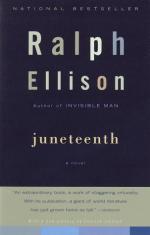|
This section contains 273 words (approx. 1 page at 400 words per page) |

|
Juxtaposition
Through the use of contrasting images, e.g., light and darkness, and emotions, e.g., bliss and fear, Ellison underscores the impact race has on the characters in the South prior to the Civil Rights movement. In one scene, parishioners are engrossed in the power and vitality of salvation and the Word, and then they are suddenly wrought with fear regarding the backlash they will endure from having to wrestle a deranged, white woman out there revival. Juxtaposing these feelings and images allows Ellison to reveal the heart of race relations in the South. He is able to exemplify the intelligence, integrity and devotion of black Americans in opposition to the oppression and racism imposed on them during this time in history.
Figurative Language
Figurative language is a technique imposed by Ellison in Juneteenth to interrupt the order of his storytelling. The novel is composed of the linear...
|
This section contains 273 words (approx. 1 page at 400 words per page) |

|




